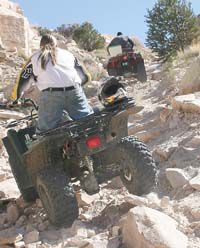| A young man heads up some steep terrain near the town of East Carbon. It is important to remember that Utah state law requires anyone under the age of 18 to wear a helmet when riding an ATV. |
The East Carbon council made it clear that several changes need to be made to the city’s off highway vehicle ordinance, during their Nov. 13 meeting. Changes, that the council hopes will make East Carbon a more OHV rider-friendly community, according to statements made by the mayor and council. The issue raised so many questions it was tabled for further investigation and discussion.
“The decision we have to make is are we going to be ATV friendly or not,” said East Carbon Mayor Orlando LaFontaine. “Because once the ordinance is set in place our law enforcement officers will not have discretion on who they do and don’t cite, we are going to have to be very clear with the language we use.”
The mayor’s comments were given after the council made changes to the OHV ordinance the focus of the meeting, discussing the proposed change off and on for over an hour.
“The current changes to the OHV ordinance will make it possible and legal for all riders to ride their all-terrain vehicle from their home to the nearest trailhead,” said East Carbon Councilmember Joyce Caviness. “Also four wheeler owners would be able to ride on all city streets when pushing snow during the winter. That does not mean that an individual can put their plow on and drive their motorbike around town when there is no snow to be pushed.
While most members of the council expressed an interest in keeping OHV laws as rider friendly as possible some within the governing body do want to see some tougher restrictions considers portions of the community.
“I live on Denver Avenue and right behind our home is an ATV drag strip,” said East Carbon Councilmember David Maggio. “The dust is killing the whole street, not to mention the fact that a lot of that area is private property.”
Maggio reported that he is a proponent of OHVs and ATVs but feels that some restrictions need to be made within the small municipality. Chiefly the marking of private property in order to keep riders off private land.
According to councilmember Caviness the real problem is the fact that there is no clear cut path through the city of East Carbon, making it difficult for riders to reach some trailheads or get gas when they need to.
“I think that if we develop a rider friendly law and just get people to stay off of private property then everything will be okay, then everybody could get to the gas station without there being a problem,” said councilmember Darlene Kuhns. “I would say 70 percent of this community owns an ATV and they all like to ride.”
| Newly elected and current councilmember Terry Harrison shares his views that OHV access is vital to the citizens of East Carbon. |
One of Kuhn’s main contentions has been the fact that riders speed up private property that runs parallel to her beauty salon.
“The speed at which they come over that hill and the fact that we have older people coming into the shop creates a very dangerous scenario,” said Kuhns in an earlier meeting.
The state OHV site states that it is a rider’s responsibility to protect their privilege to ride by riding only in areas designated as open to OHV. The burden has now fallen on the council to designate those areas.
The speed at which riders proceed on public roads was also a topic of discussion. Sunnyside recently posted 10 miles per hour as their ATV speed limit and East Carbon is watching their community’s response as a way to possibly determine their own speed limit.
Just before the issue was tabled East Carbon citizen, Marcus Palacios, brought up Salina’s laws, recommending that the city consider adopting similar ordinances.
According to Palacios, riders in Salina are allowed to ride on all public streets, including paved areas as long as they adhere to the city’s laws.
During a community debate, councilmember, Terry Harrison who was appointed to the council earlier this year and recently voted into a four year term, made his opinion about ATVs abundantly clear.
“I own ATVs myself and when I came to this community I was amazed at the amount of riding that is available,” said Harrison. “I feel it is something our community could capitalize on to promote economic growth via tourism as well as a continued activity for young and old alike in our city.”

